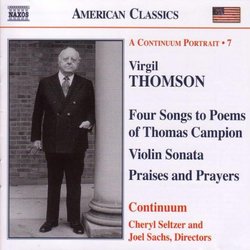| All Artists: Thomson, Lang, Wu, Krakaue, Evans, Sachs Title: Continuum Portrait Members Wishing: 0 Total Copies: 0 Label: Naxos American Original Release Date: 1/1/2005 Re-Release Date: 9/20/2005 Genre: Classical Styles: Chamber Music, Historical Periods, Classical (c.1770-1830) Number of Discs: 1 SwapaCD Credits: 1 UPC: 636943919828 |
Search - Thomson, Lang, Wu :: Continuum Portrait
 | Thomson, Lang, Wu Continuum Portrait Genre: Classical
|
Larger Image |
CD Details |
CD ReviewsGreat Music from an American Individualist alk bender | Marshfield, WI | 08/04/2009 (4 out of 5 stars) "It seems like when I read things about Virgil Thomson, they always start out saying what an important figure he was in American music, but then ends up sort of making him sound like a second rate composer. Even when Leonard Bernstien wrote about him after his death, he seemed to make it sound like Thomson's real legacy was his prose and his influence on Aaron Copland, not his music in and of itself.
I don't think this is fair. Thomson's music was individual, not caught up in trends. He had his own musical vision that was based on simplicity and humor. His music was mostly consonant, but sought to combine the tradition of classical and folk music with modern sounds and aesthetics. His music was cheeky, yet unpretentious, and he was usually ahead of his time. While most American composers (including Aaron Copland), were focusing on radical music tecniques in the 20s, Thomson was writing Synthetic Waltzes, a work that is a real joy to listen to, while still throwing enough misbehaviour into the melody to keep it interesting and fresh. This style, as well as the Americana style of Thomson's Symphony on a Hymn Tune(written 1928), was a real precursor to the consonant, folk based music that would become popular in the next decade. The Sonata for Violin and Piano, is once again based mostly on tonality and strong melody (one of the best things about Thomson is that he pretty much always has a good melody somewhere in his music). But at the same time, it is playful and has it's moments of dissonance. One of my favorite moments sounds like a child learning how to play violin but not quite getting it right. The songs are all either beautiful or interesting. The songs by Thomas Campion fall into the beautiful category, with an interesting setting for clarinet, viola, and harp. Follow thy Fair Sun is the one that sticks with me, even while the instumentation is just based on simple arpeggios. But it works, and it's a joy to listen to. In Two by Marianna Moore, Thomson wisely keeps the piano spare so as to let the very eclectic words take center stage. One of the most interesting pieces on this collection is Prayers and Praises. While its basis is rather traditional religious texts and melodies, the piano accompaniment is very unique. The piano at times seems to float along on a plane of it's own, and then at other times intersects with the melody, then goes off again on it's own. What I find intersting about this is that so often religious texts seem to be treated with such reverance or such seriousness, while here Thomson, without being irreverant, really seems to experiment and play with the relationship between text, melody, and accompaniment. In conclusion, Virgil Thomson's music should be remember as much for the value of his music itself (even if it never really fit with what the "serious" -whatever that means- American composers were doing) as for it's influence on other composers. I gave this CD 4 stars because, while this collection is certainly interesting and enjoyable, Thomson's real masterpieces are The Plow That Broke The Planes and The River, and if you are new to Thomson, I would recommend you start with those. Then you can come back and buy this collection: it makes a great addition to a Thomson library." |

 Track Listings (16) - Disc #1
Track Listings (16) - Disc #1